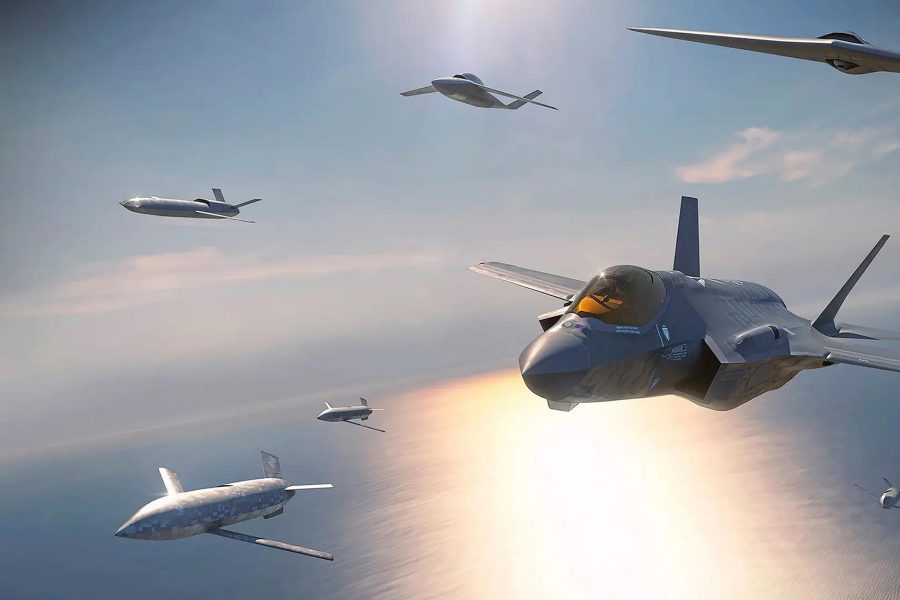The Air Force awarded contracts to five companies to design and build Collaborative Combat Aircraft that can fly autonomously alongside manned platforms, a spokesperson confirmed. They are:
- Boeing
- Lockheed Martin
- Northrop Grumman
- Anduril
- General Atomics
Acting Air Force Undersecretary Krysten E. Jones had disclosed Jan. 24 at the Center for Strategic and International Studies that five companies had been selected, but did not specify the winners.
Details about the contracts remain under wraps. The spokesperson said only that the companies are “under contract to continue rapid development for production for CCA.”
Anduril released a statement Jan. 25 confirming its selection, and spokespeople for Northrop Grumman and Boeing confirmed their selections to Air & Space Forces Magazine. General Atomics and Lockheed Martin did not immediately respond to requests for comment.
“We commend Secretary Kendall and the U.S. Air Force for their leadership and commitment to integrating new technologies into the force,” Anduril’s release stated. “Anduril was founded to transform U.S. and allied defense capabilities with software and hardware, combining technology including artificial intelligence and computer vision with a rapid approach to autonomous hardware development and manufacturing for defense platforms. We are honored to be the only non-traditional defense company selected to be a part of the CCA program.”
The Boeing spokesperson said the company is “honored to participate in the program and confident in our ability to provide the U.S. Air Force a capable, versatile, and affordable Collaborative Combat Aircraft fleet that can be produced efficiently and delivered at scale.”
Northrop is “working closely with the U.S. Air Force … using our extensive expertise in advanced manufacturing, digital technologies and autonomous systems to deliver Collaborative Combat Aircraft capabilities rapidly and affordably,” their spokesperson said.
The Air Force envisions CCA as an uncrewed, relatively low-observable aircraft that can escort or coordinate with crewed aircraft, performing missions such as electronic warfare, suppression of air defenses, communications, or as a flying extra magazine of weapons. Adding these aircraft could provide additional critical “mass” in a peer conflict, expanding the combat force at lower cost than crewed aircraft.
USAF officials have indicated they want to move quickly on the program, even as experimentation and testing on manned-unmanned teaming continues. The service has advanced the concept through efforts like its Skyborg and X-62 programs.
In its fiscal 2024 budget request, the Air Force outlined plans to spend $5.8 billion on CCAs over the next five years, and $392 million in fiscal ’24 alone. That figure is a small down payment on what is shaping up to be an enormous program. While Air Force Secretary Frank Kendall has set 1,000 CCAs as a working number of such aircraft—a figure intended to signal to developers just how seriously he views the program—he has said the Air Force will need far more. Last March, he told the McAleese defense conference, “We’ll end up with more than that. …It could be twice that number or more.”
Industry has responded enthusiastically. General Atomics unveiled its concept for a “Gambit” series of uncrewed aircraft last spring, with optional external configurations optimized for sensing, fighter escort, defense suppression and ground attack, all using a common core to increase commonality and modularity. Anduril, meanwhile, is pushing its “Fury” aircraft—originally developed as an autonomous and stealthy “red air” option—as a multi-mission solution.
Progress threatens to be slowed as the Air Force, along with the rest of the Pentagon and other federal agencies, waits for Congress to pass a fiscal 2024 budget. As things currently stand with the government operating under a continuing resolution, the Air Force can conduct some CCA actions using authorized and appropriated fiscal 2023 funds, but much of the program is considered a “new start” and is on hold.
Regardless, while the Air Force has selected five companies to work on the project for now, service acquisition executive Andrew Hunter has said the objective is to have “on-ramps” for companies not picked in the initial rounds, so that missing a contract now does not preclude participation later.
